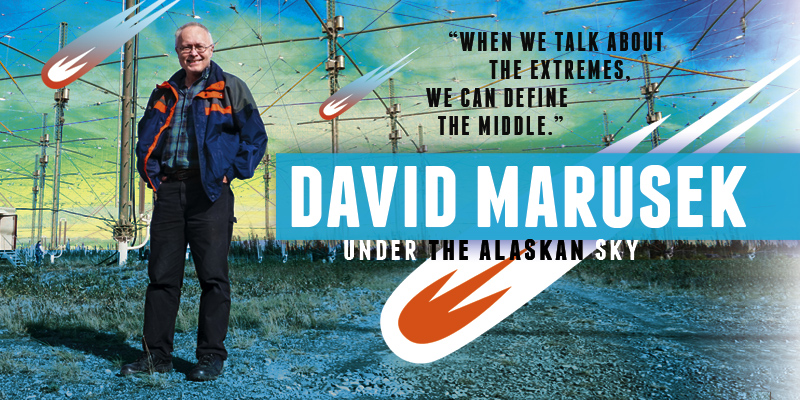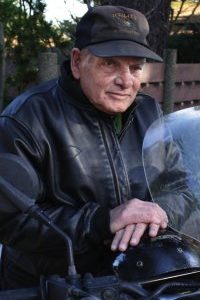David Marusek: Under the Alaskan Sky

DAVID MARUSEK was born January 21, 1951 in Buffalo NY, and grew up all over the US. He attended UC Santa Barbara from 1969-73, earning a degree in cultural anthropology. That year he moved to Alaska, where he has lived ever since. He was married and divorced, and has an adult daughter. He has worked in construction, surveying, as a hospital attendant, and an ad salesman, but most of his career was spent as a graphic designer, including many years teaching graphics at the University of Alaska in Fairbanks.
Marusek became serious about writing in 1986, and attended Clarion West in 1992. First story “The Earth Is on the Mend” appeared in Asimov’s in 1993. Some of his short works include Sturgeon Memorial Award finalist “We Were Out of Our Minds with Joy” (1995), “Getting to Know You” (1997), “Yruek Rutz, Yurek Rutz, Yurek Rutz” (1999), “Cabbages and Kale (1999), Nebula Award finalist and Sturgeon Award winner “The Wedding Album” (1999), “A Boy in Cathyland” (2001), “Osama Phone Home” (2008), and “Extreme Bedding” (2017). Some of his short fiction was collected in Getting to Know You (2008).
First novel Counting Heads (2005) was a John W. Campbell Memorial Award finalist, and sequel Mind Over Ship (2009) won the Endeavour Award. His latest book, Upon This Rock, is self-published, and launches the Upon This Rock series.
Excerpts from the interview:
“A number of reviews I’ve gotten for Upon This Rock have kindly welcomed me back to the fold, as though I’d dropped out of the writing game and only now returned. I’d like to thank them, but also to point out that I’ve been here the whole time. It’s true I haven’t put out any major new work since Mind Over Ship in 2009 (except for two non-science fiction anthologies that I co-edited), but I’ve been writing without break all these years, no less than four hours a day, five days a week (plus business chores on Saturdays). In that time I started three new novels and spent about a year each on two of them, only to see them crash and burn in their second or third drafts. That’s no way to make a living, and I hated to see them go, but they were dead ends. Not a total loss, however, because some spark of life carried over from one project to the next.
“The first ill-fated book was tentatively named The Holy Family and was set in a midwestern state. It actually got to the third draft, and I sent an early look to my agent at the time, Ralph Vicinanza, for his take. He wrote back saying he didn’t understand what it was that I’d sent him. The project died the same day. I couldn’t defend it; I didn’t feel I ‘owned’ the story or characters enough to continue. The second and third novel attempts were not science fiction, were set in Alaska, were collaborations with other Alaska authors, and revolved around the life of a certain firebrand Alaska governor. Each book died for different reasons, but not before consuming months and months of effort. I tried turning my attention to completely unrelated stories, but my imagination kept coming back to the living ember of the failed stories. In 2013, I saw the light and have been happily working on Upon This Rock ever since.
“I moved to Alaska in 1973. I was born in New York, and my father moved the family every four or five years progressively West, through Michigan, Illinois, Texas, and California. California is where I left home and attended college. I skipped out on my college graduation ceremony to hitchhike to Alaska. My research for the Upon This Rock series involves mostly just living up here. I have resided in Alaska so long, and yet my fiction has never really addressed Alaska. I love this place. In a way this series will be my love letter to Alaska.
“It’s also a look at mythology through a science fiction lens. People commonly understand myths to be false or fictional beliefs. There are classical myths about ancient Titans and demigods, as well as modern urban myths about alligators in the sewers of New York or vaccinations that cause autism. To call something a myth is to dismiss it as untrue.
“I prefer another definition: a myth is a society’s best current explanation of reality. It’s the way things are. Lightning and thunder show the gods’ displeasure. We are born in sin and in need of a Savior. The Earth is the center of the universe. That sort of thing. Mythic truth only becomes false when the society evolves over time and replaces it with new myths.
“The operative myth in the West today tells us that the reality of the universe is best understood through the objective methodology of science, rather than through the inerrant word of scripture. And yet, especially here in America, many (if not most) people still operate under many rules of Christian mythology. Our society has become a clumsy giant with a split personality, and the trouble this sort of dysfunction causes is a major theme of Upon This Rock. That’s how I found myself writing a science fiction novel about religious faith and the ‘clash of mythologies,’ with help from a mendacious space alien with its own agenda.
“Why did I choose a family of Christian fundamentalists to be major characters? Because when we talk about the extremes, we can define the middle. I do believe I have all positions represented in the story: I have the agnostics, I have conventional Christians, and I have the religious extremists on both sides. I dedicated this book to one of my sisters, who is a fundamentalist Christian. She doesn’t live in Alaska, but I found out from her what denomination she belongs to, and I asked her to ask her pastor about her church’s beliefs or teaching about extraterrestrials. I could not get an answer from her pastor, so I had to explore that question with other sources. As part of my research I located a church belonging to my sister’s denomination here in Fairbanks, and I have to tell you, we have a lot of churches in Fairbanks. Our society is steeped in religion of one sort or another. I sought out this fundamentalist denomination and started attending Bible study Wednesday nights with them. I admitted to them that I was an unbeliever and that I was interested in seeing the Bible from their point of view and wanted to study it with them if they’d allow me. Also, I do have a religious background myself – I was raised Catholic and I even attended seminary for the priesthood as a teenager.”
Interview design by Stephen H. Segal. Photo furnished by David Marusek. Read the complete interview in the November 2017 issue of Locus Magazine.







